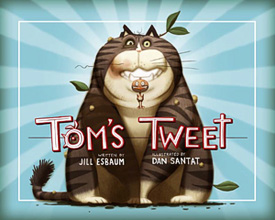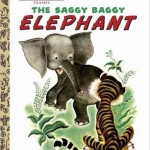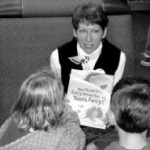How to Write a Picture Book for Children That Will Sell
What is a Picture Book

Tom’s Tweet by Jill Esbaum (art by Dan Sanat)
From Dictionary.com, we have this definition of a picture book – a book consisting mainly or entirely of pictures, esp. one for children who have not yet learned to read.
I know a lot of writers, including myself, who would disagree with that definition. Picture books aren’t only for 2-5 year olds who have not yet learned to read. One of the most fun times I have with my son is his following along in the books I read to him. He knows how to read, but we enjoy a time together, sharing a book. Sometimes he takes a character and reads it, while I read the rest. Reading a picture book with your child or a classic book like Treasure Island with your older children is a great time for bonding.
There are many different types of picture books. There are wordless books (pictures only) and some picture books that have very few words, maybe 3-4 on each page, sometimes under one hundred for the entire text. A typical word count for a children’s picture book now averages between 300-600 words, depending on what end of the age spectrum for which you are writing. Of course, there are exceptions to this rule.
If you research this subject, you will notice a trend in picture books over the years. That trend is the downward spiral of word counts. Read any Golden Book published in the late 70s to early 80s. If you are a talented writer or have that talent deep inside, you will easily spot numerous words which do not move the story forward or words that tell the reader something the pictures already show. Each time I read a Golden Book from that era, I want to get a red marker out and start editing.
Writing a picture book that will sell is an extremely difficult endeavor. Wait! Let me re-phrase that last statement. Writing a picture book which will sell in our tough economic times is an extremely difficult endeavor. Remember, the words you type up on a Word document or scribble on paper need to be so amazingly well put together (plot, characters, rhythm), that they will demand at least $19.99 at your local Barnes and Noble or on Amazon.com.
Do you still want to write a picture book?
Okay, now that it’s just you and me here, let’s go.

Picture book writers have their identities stolen too
The Rules for Writing a Picture Book
The rules are simple. First make up your mind to do it. Inspiration is everywhere. If you have children, that inspiration can be in a family situation. If you’re young enough to remember your childhood, think of the funniest thing that happened in the second grade. Did your best friend fall into the penguin pit on your zoo field trip? Did you ever have a snow day? I can’t tell you how many picture books there are out there about snow days. What about re-telling a fairy tale you heard as a child? Tell it with a different setting, modern day, cowboy, in a foreign land, make all the characters yaks, etc. Ideas are endless.
Next, you must make sure your characters are interesting and unique. Billy the basketball is the name of one character I created. He was the star of a story I wrote in the 5th grade. For the sake of all picture book editors out there, do not write about a talking basketball.
After characters are chosen, you must make sure your story has a problem. Who solves this problem is often a difficult decision for beginning authors. Should it be the smart mother or father or other adult figure? No. What about the child or child-like figure if writing story with animal characters? Yes, if the problem solver is your main character. Main characters should solve the problem in your story.
Some editors, wait, this might be most editors, want to see less adults in children’s picture books. I don’t always abide by this rule. Let me re-phrase that too. I rarely abide by that rule. One picture book I wrote and received two revision requests for from editors at major publishing houses, had a loving father in the story. One editor wanted to make sure he wasn’t the typical bumbling Daddy. That was a surprise. If parents are in your story, make sure they do not solve the problem. The children or child-like characters do the problem solving.
Writing a picture book that sells is a difficult thing to do. Because of this, you must make every word count and try to limit your count to 600 words max. After you finish your first draft, you will have to do a revision, maybe many revisions. “Amp up the humor as much as possible in your revisions.” I read that bit of advice from Tammi Sauer, author of Chicken Dance, Me Want Pet and Cowboy Camp among others. She’s a star in the picture book world.
Get Critiqued and Learn
If you plan on writing a picture book that sells, don’t chisel that plan in stone simply because your Aunt Rose or your next door neighbor say your stories are great. Get into a critique group with others that share your goal. If you write picture books, start or join a picture book critique group. Exchange manuscripts either in person or online. You will learn valuable lessons from other writers. Eventually, you will write new manuscripts with that advice in mind. You will be self-editing and creating better stories every year.
If you are at the point where you think a paid critique would benefit your writing, there are plenty of pros (published authors) who offer this service. Their fees are generally $100 a critique. This terrible economy may have some writers lowering their prices, but costs could go the other way too.
If you are interested in a great critique from a non-professional (read: unpublished author) with eight years of critique experience and some near misses in the publishing world, please contact me. My prices are $30.00 for picture books under 1000 words (if you read the rules above, you know those picture books you’ve written better be under 1000 words.) I will provide you with a detailed critique with suggested deletions and additions. The more often I work with you as your craft improves, later critiques will come along with suggested names and addresses of editors who have expressed interest in your type of story.
The above are just a few of my scattered thoughts on how to write a picture book that will sell. As I say to each of my critique partners, “Take what you can use, and discard the rest.”
More Advice
If you follow the guidelines above, you’re off to a great start to writing a picture book that will sell. If you write, please add your tips below in the comment section. The more advice the merrier.
If you want to learn more about writing a picture book, please visit http://verlakay.com and http://scbwi.com. These two websites have message boards filled with advice on writing a picture book and selling it too.









